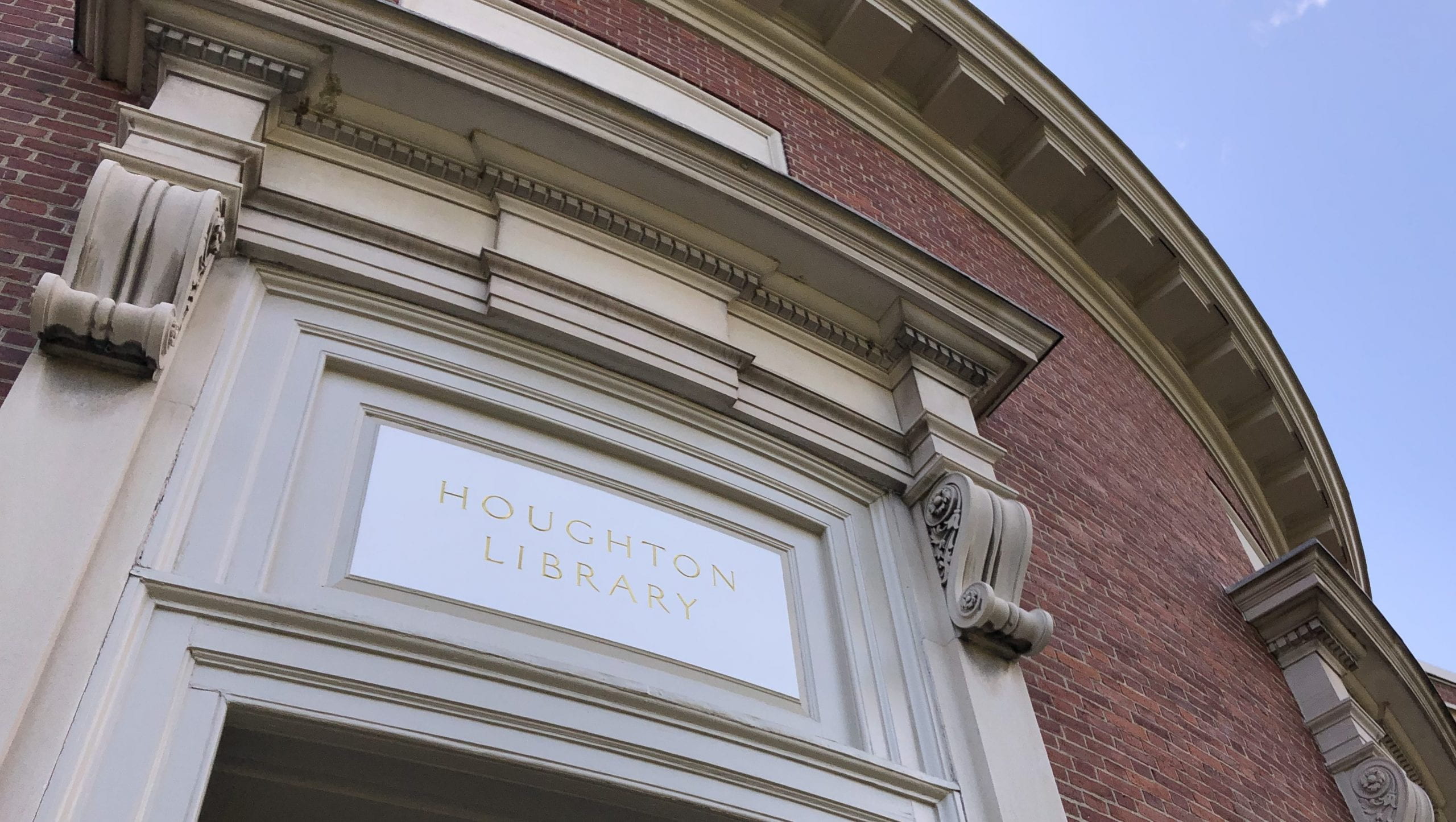
This post is a condensed version of an essay from the catalogue of Houghton Library’s most recent exhibition, Small Steps, Giant Leaps: Apollo 11 at Fifty, which is on view from April 29 – August 3, 2019. Follow us on Instagram, where we will feature images from the exhibition every Monday during its run.
In 1969, 600 million people watched Commander Neil Armstrong descend the lunar module Eagle’s ladder, stand on the moon, and remark, “That’s one small step for [a] man, one giant leap for mankind.” Armstrong’s achievement was the culmination of a series of small steps and giant leaps in human understanding and innovation, advances driven by the curiosity and wonder of countless generations who had looked up at the heavens.
The story of Apollo 11 is fascinating because it involves so many interconnected developments in the history of math and science, engineering and technology, and travel and exploration, driven by both peaceful inquiry and military necessity. Its origins can be traced to the beginning of the scientific revolution, when, in April 1543, Nicolaus Copernicus published De revolutionibus orbium coelestium (On the Revolutions of the Heavenly Spheres), which showed that astronomical calculations are made much simpler by assuming the earth revolves around the sun, rather than sitting still at the center of the universe.
In 1609 and 1610, Johannes Kepler and Galileo Galilei published their respective works, Astronomia Nova (New Astronomy) and Sidereus Nuncius (Starry Messenger). Kepler’s first law of planetary motion, based on detailed observational data, demonstrated that orbits were elliptical rather than circular. By using one of the first telescopes, Galileo discovered that Jupiter had four predictably orbiting moons, and that our own moon, rather than being the perfectly smooth sphere imagined by Aristotle, was covered in mountains and craters.

The successive insights of Copernicus, Kepler, and Galileo, along with advancements in physics contributed by René Descartes and Isaac Newton, gave humanity the tools required to precisely describe—and therefore accurately predict—the motion of objects ranging from an apple falling off a tree to a rocket carrying astronauts bound for the moon.
Over 300 years later, as World War II ended and the Cold War began, competition between the United States and the Soviet Union to develop nuclear-weapon-tipped missiles led to increasingly advanced rocket technology. In October 1957, the Soviets took the lead in the “space race” with the launch of Sputnik, Earth’s first artificial satellite. In April 1961, they again beat the United States by sending the first person to space when the Vostok 1 mission carried Yuri Gagarin into orbit.
On May 25, 1961, President John F. Kennedy issued an audacious challenge: “I believe that this nation should commit itself to achieving the goal, before this decade is out, of landing a man on the moon and returning him safely to the Earth.” Over the 1960s, NASA’s budget would grow from 0.5 percent of federal spending to a peak of almost 4.5 percent, and an estimated 400,000 people were employed to achieve Kennedy’s ambitious goal.
The path to a successful lunar landing was filled with obstacles, including many near misses and a tragic accident that claimed the lives of the Apollo 1 crew. Following that tragedy, NASA officials increased their focus on making the countless systems on which the missions depended as robust as possible, working to simulate every imaginable contingency.
Margaret Hamilton, a pioneering computer scientist working at MIT, led the team that developed software for the complex onboard Apollo Guidance Computer (AGC). Its operating system creatively handled multiple tasks at once, with priority codes ensuring that essential calculations were completed first. This feature would be decisive in enabling the Apollo 11 lunar landing to continue despite a series of data errors during when the mission was underway.
The trouble began even before the Eagle’s descent. When it undocked from the command module Columbia, a puff of air in the tunnel between the two spacecraft, which had not been vented in advance, created a force that gave Eagle unexpected forward motion. In the vacuum of space, such motion accumulated over the course of the descent, leaving Eagle far downrange from the intended landing site. Problems continued due to an engineering flaw in Eagle’s rendezvous radar system, which tracked Columbia and was left on during the descent phase in case an abort required urgent docking. The radar system began to inundate the AGC with unnecessary signals, competing with other processes for scarce computing resources and overwhelming the processor.
Once the program alarms were dealt with, Armstrong and Lunar Module Pilot Buzz Aldrin noticed they were headed toward a boulder-strewn crater rather than their intended landing site. Using his expertise from the LLRV training, Armstrong manually guided Eagle horizontally to a more suitable location, consuming precious fuel in the process. When he landed with fewer than thirty seconds of fuel remaining, mission control breathed a sigh of relief.

To help determine their location and calibrate Eagle’s guidance system, Armstrong and Aldrin used a star chart. They also used the position of planet Earth—which, for the first time in the long history of celestial navigation, appeared in the sky over the heads of two humans, standing on another heavenly sphere and riding on the shoulders of giants: Copernicus, Galileo, and Newton, as well as the 400,000 men and women who worked on the Apollo program.

